display CHEVROLET COLORADO 2006 1.G Workshop Manual
[x] Cancel search | Manufacturer: CHEVROLET, Model Year: 2006, Model line: COLORADO, Model: CHEVROLET COLORADO 2006 1.GPages: 434, PDF Size: 2.57 MB
Page 211 of 434
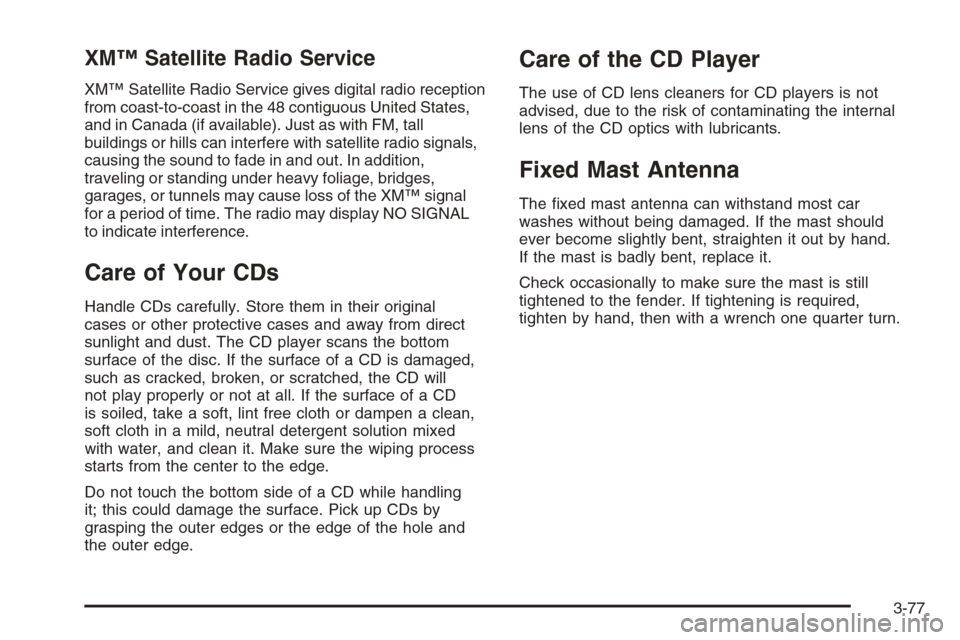
XM™ Satellite Radio Service
XM™ Satellite Radio Service gives digital radio reception
from coast-to-coast in the 48 contiguous United States,
and in Canada (if available). Just as with FM, tall
buildings or hills can interfere with satellite radio signals,
causing the sound to fade in and out. In addition,
traveling or standing under heavy foliage, bridges,
garages, or tunnels may cause loss of the XM™ signal
for a period of time. The radio may display NO SIGNAL
to indicate interference.
Care of Your CDs
Handle CDs carefully. Store them in their original
cases or other protective cases and away from direct
sunlight and dust. The CD player scans the bottom
surface of the disc. If the surface of a CD is damaged,
such as cracked, broken, or scratched, the CD will
not play properly or not at all. If the surface of a CD
is soiled, take a soft, lint free cloth or dampen a clean,
soft cloth in a mild, neutral detergent solution mixed
with water, and clean it. Make sure the wiping process
starts from the center to the edge.
Do not touch the bottom side of a CD while handling
it; this could damage the surface. Pick up CDs by
grasping the outer edges or the edge of the hole and
the outer edge.
Care of the CD Player
The use of CD lens cleaners for CD players is not
advised, due to the risk of contaminating the internal
lens of the CD optics with lubricants.
Fixed Mast Antenna
The �xed mast antenna can withstand most car
washes without being damaged. If the mast should
ever become slightly bent, straighten it out by hand.
If the mast is badly bent, replace it.
Check occasionally to make sure the mast is still
tightened to the fender. If tightening is required,
tighten by hand, then with a wrench one quarter turn.
3-77
Page 212 of 434
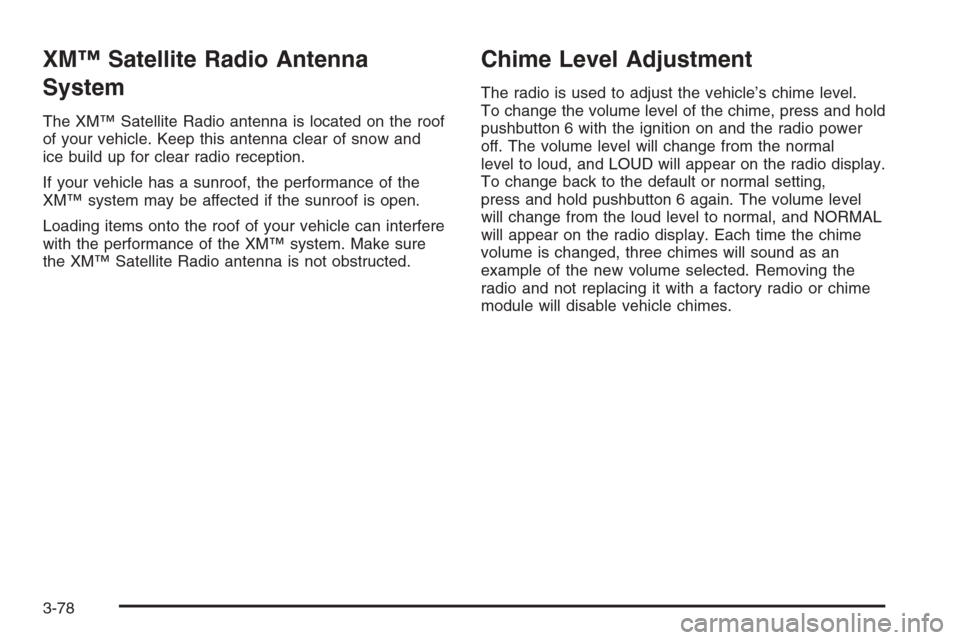
XM™ Satellite Radio Antenna
System
The XM™ Satellite Radio antenna is located on the roof
of your vehicle. Keep this antenna clear of snow and
ice build up for clear radio reception.
If your vehicle has a sunroof, the performance of the
XM™ system may be affected if the sunroof is open.
Loading items onto the roof of your vehicle can interfere
with the performance of the XM™ system. Make sure
the XM™ Satellite Radio antenna is not obstructed.
Chime Level Adjustment
The radio is used to adjust the vehicle’s chime level.
To change the volume level of the chime, press and hold
pushbutton 6 with the ignition on and the radio power
off. The volume level will change from the normal
level to loud, and LOUD will appear on the radio display.
To change back to the default or normal setting,
press and hold pushbutton 6 again. The volume level
will change from the loud level to normal, and NORMAL
will appear on the radio display. Each time the chime
volume is changed, three chimes will sound as an
example of the new volume selected. Removing the
radio and not replacing it with a factory radio or chime
module will disable vehicle chimes.
3-78
Page 221 of 434
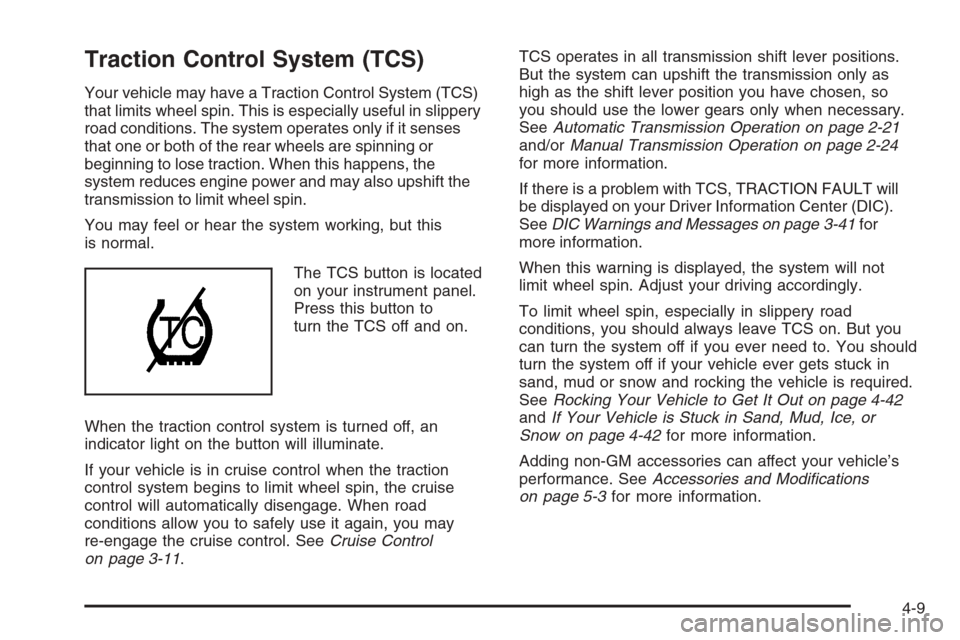
Traction Control System (TCS)
Your vehicle may have a Traction Control System (TCS)
that limits wheel spin. This is especially useful in slippery
road conditions. The system operates only if it senses
that one or both of the rear wheels are spinning or
beginning to lose traction. When this happens, the
system reduces engine power and may also upshift the
transmission to limit wheel spin.
You may feel or hear the system working, but this
is normal.
The TCS button is located
on your instrument panel.
Press this button to
turn the TCS off and on.
When the traction control system is turned off, an
indicator light on the button will illuminate.
If your vehicle is in cruise control when the traction
control system begins to limit wheel spin, the cruise
control will automatically disengage. When road
conditions allow you to safely use it again, you may
re-engage the cruise control. SeeCruise Control
on page 3-11.TCS operates in all transmission shift lever positions.
But the system can upshift the transmission only as
high as the shift lever position you have chosen, so
you should use the lower gears only when necessary.
SeeAutomatic Transmission Operation on page 2-21
and/orManual Transmission Operation on page 2-24
for more information.
If there is a problem with TCS, TRACTION FAULT will
be displayed on your Driver Information Center (DIC).
SeeDIC Warnings and Messages on page 3-41for
more information.
When this warning is displayed, the system will not
limit wheel spin. Adjust your driving accordingly.
To limit wheel spin, especially in slippery road
conditions, you should always leave TCS on. But you
can turn the system off if you ever need to. You should
turn the system off if your vehicle ever gets stuck in
sand, mud or snow and rocking the vehicle is required.
SeeRocking Your Vehicle to Get It Out on page 4-42
andIf Your Vehicle is Stuck in Sand, Mud, Ice, or
Snow on page 4-42for more information.
Adding non-GM accessories can affect your vehicle’s
performance. SeeAccessories and Modi�cations
on page 5-3for more information.
4-9
Page 299 of 434
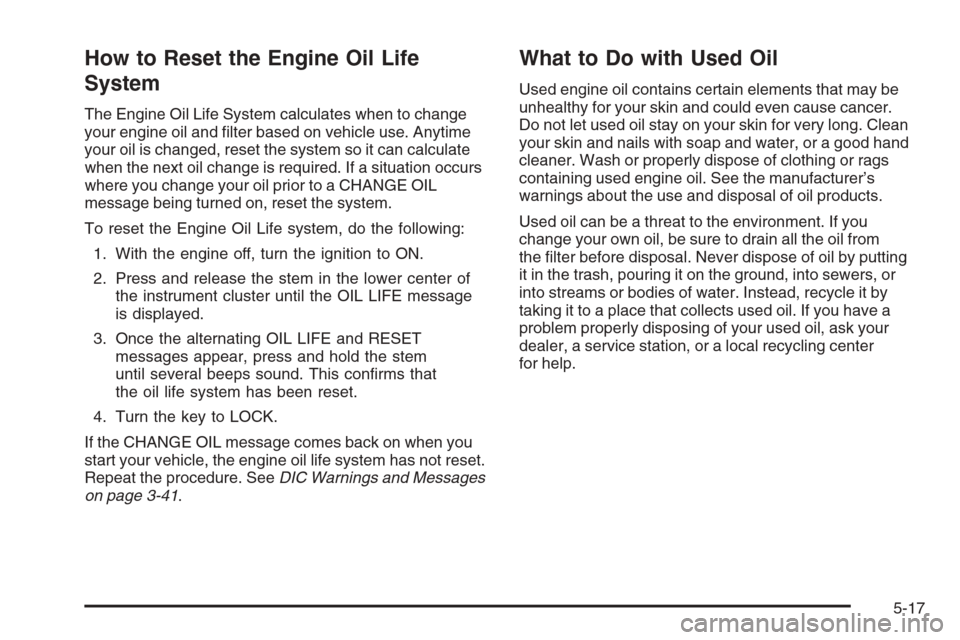
How to Reset the Engine Oil Life
System
The Engine Oil Life System calculates when to change
your engine oil and �lter based on vehicle use. Anytime
your oil is changed, reset the system so it can calculate
when the next oil change is required. If a situation occurs
where you change your oil prior to a CHANGE OIL
message being turned on, reset the system.
To reset the Engine Oil Life system, do the following:
1. With the engine off, turn the ignition to ON.
2. Press and release the stem in the lower center of
the instrument cluster until the OIL LIFE message
is displayed.
3. Once the alternating OIL LIFE and RESET
messages appear, press and hold the stem
until several beeps sound. This con�rms that
the oil life system has been reset.
4. Turn the key to LOCK.
If the CHANGE OIL message comes back on when you
start your vehicle, the engine oil life system has not reset.
Repeat the procedure. SeeDIC Warnings and Messages
on page 3-41.
What to Do with Used Oil
Used engine oil contains certain elements that may be
unhealthy for your skin and could even cause cancer.
Do not let used oil stay on your skin for very long. Clean
your skin and nails with soap and water, or a good hand
cleaner. Wash or properly dispose of clothing or rags
containing used engine oil. See the manufacturer’s
warnings about the use and disposal of oil products.
Used oil can be a threat to the environment. If you
change your own oil, be sure to drain all the oil from
the �lter before disposal. Never dispose of oil by putting
it in the trash, pouring it on the ground, into sewers, or
into streams or bodies of water. Instead, recycle it by
taking it to a place that collects used oil. If you have a
problem properly disposing of your used oil, ask your
dealer, a service station, or a local recycling center
for help.
5-17
Page 398 of 434
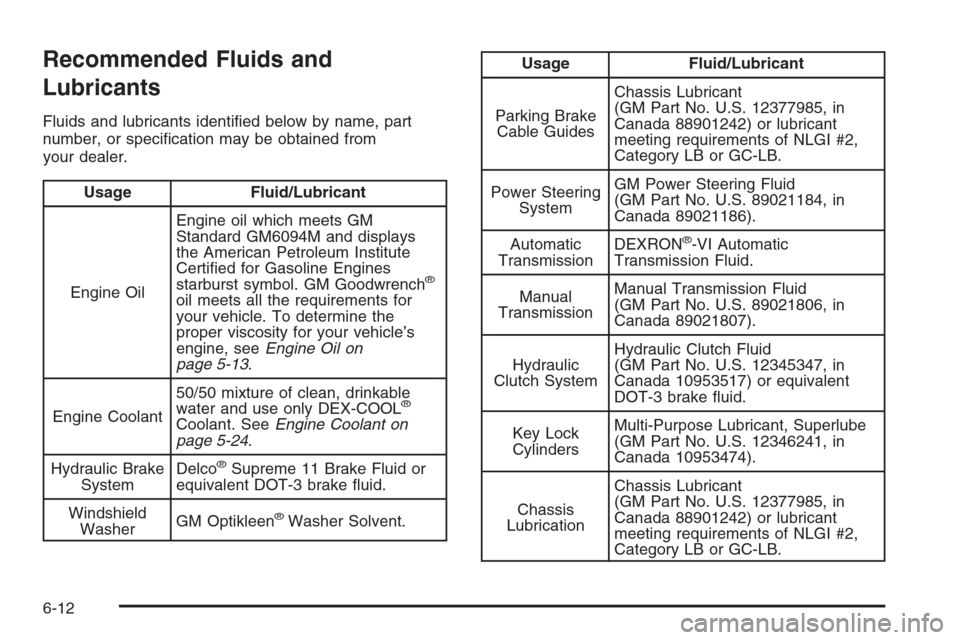
Recommended Fluids and
Lubricants
Fluids and lubricants identi�ed below by name, part
number, or speci�cation may be obtained from
your dealer.
Usage Fluid/Lubricant
Engine OilEngine oil which meets GM
Standard GM6094M and displays
the American Petroleum Institute
Certi�ed for Gasoline Engines
starburst symbol. GM Goodwrench
®
oil meets all the requirements for
your vehicle. To determine the
proper viscosity for your vehicle’s
engine, seeEngine Oil on
page 5-13.
Engine Coolant50/50 mixture of clean, drinkable
water and use only DEX-COOL
®
Coolant. SeeEngine Coolant on
page 5-24.
Hydraulic Brake
SystemDelco
®Supreme 11 Brake Fluid or
equivalent DOT-3 brake �uid.
Windshield
WasherGM Optikleen
®Washer Solvent.
Usage Fluid/Lubricant
Parking Brake
Cable GuidesChassis Lubricant
(GM Part No. U.S. 12377985, in
Canada 88901242) or lubricant
meeting requirements of NLGI #2,
Category LB or GC-LB.
Power Steering
SystemGM Power Steering Fluid
(GM Part No. U.S. 89021184, in
Canada 89021186).
Automatic
TransmissionDEXRON
®-VI Automatic
Transmission Fluid.
Manual
TransmissionManual Transmission Fluid
(GM Part No. U.S. 89021806, in
Canada 89021807).
Hydraulic
Clutch SystemHydraulic Clutch Fluid
(GM Part No. U.S. 12345347, in
Canada 10953517) or equivalent
DOT-3 brake �uid.
Key Lock
CylindersMulti-Purpose Lubricant, Superlube
(GM Part No. U.S. 12346241, in
Canada 10953474).
Chassis
LubricationChassis Lubricant
(GM Part No. U.S. 12377985, in
Canada 88901242) or lubricant
meeting requirements of NLGI #2,
Category LB or GC-LB.
6-12
Page 424 of 434
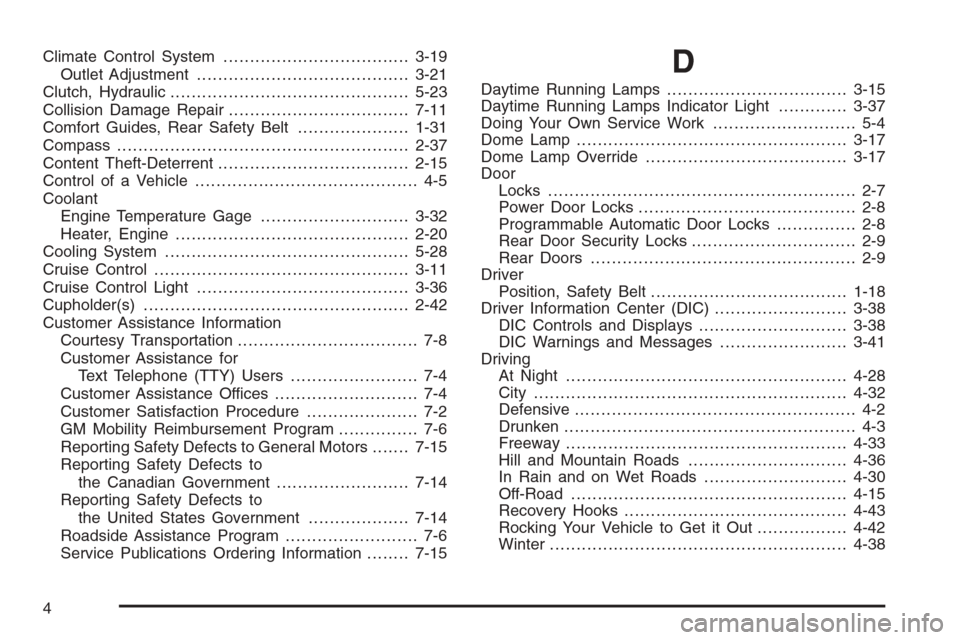
Climate Control System...................................3-19
Outlet Adjustment........................................3-21
Clutch, Hydraulic.............................................5-23
Collision Damage Repair..................................7-11
Comfort Guides, Rear Safety Belt.....................1-31
Compass.......................................................2-37
Content Theft-Deterrent....................................2-15
Control of a Vehicle.......................................... 4-5
Coolant
Engine Temperature Gage............................3-32
Heater, Engine............................................2-20
Cooling System..............................................5-28
Cruise Control................................................3-11
Cruise Control Light........................................3-36
Cupholder(s)..................................................2-42
Customer Assistance Information
Courtesy Transportation.................................. 7-8
Customer Assistance for
Text Telephone (TTY) Users........................ 7-4
Customer Assistance Offices........................... 7-4
Customer Satisfaction Procedure..................... 7-2
GM Mobility Reimbursement Program............... 7-6
Reporting Safety Defects to General Motors.......7-15
Reporting Safety Defects to
the Canadian Government.........................7-14
Reporting Safety Defects to
the United States Government...................7-14
Roadside Assistance Program......................... 7-6
Service Publications Ordering Information........7-15D
Daytime Running Lamps..................................3-15
Daytime Running Lamps Indicator Light.............3-37
Doing Your Own Service Work........................... 5-4
Dome Lamp ...................................................3-17
Dome Lamp Override......................................3-17
Door
Locks.......................................................... 2-7
Power Door Locks......................................... 2-8
Programmable Automatic Door Locks............... 2-8
Rear Door Security Locks............................... 2-9
Rear Doors.................................................. 2-9
Driver
Position, Safety Belt.....................................1-18
Driver Information Center (DIC).........................3-38
DIC Controls and Displays............................3-38
DIC Warnings and Messages........................3-41
Driving
At Night.....................................................4-28
City ...........................................................4-32
Defensive..................................................... 4-2
Drunken....................................................... 4-3
Freeway.....................................................4-33
Hill and Mountain Roads..............................4-36
In Rain and on Wet Roads...........................4-30
Off-Road ....................................................4-15
Recovery Hooks..........................................4-43
Rocking Your Vehicle to Get it Out.................4-42
Winter........................................................4-38
4
Page 429 of 434
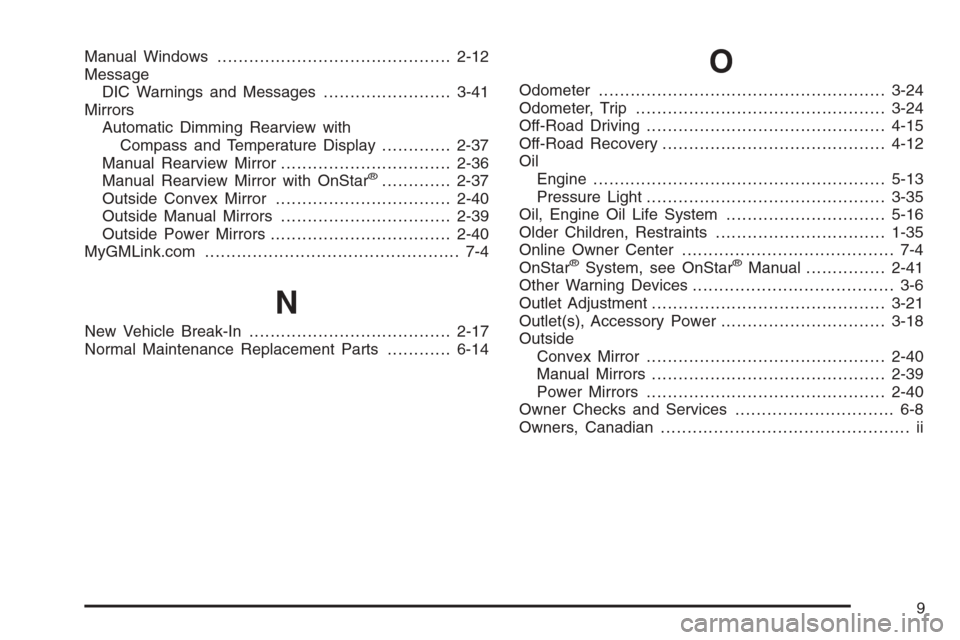
Manual Windows............................................2-12
Message
DIC Warnings and Messages........................3-41
Mirrors
Automatic Dimming Rearview with
Compass and Temperature Display.............2-37
Manual Rearview Mirror................................2-36
Manual Rearview Mirror with OnStar
®.............2-37
Outside Convex Mirror.................................2-40
Outside Manual Mirrors................................2-39
Outside Power Mirrors..................................2-40
MyGMLink.com................................................ 7-4
N
New Vehicle Break-In......................................2-17
Normal Maintenance Replacement Parts............6-14
O
Odometer......................................................3-24
Odometer, Trip...............................................3-24
Off-Road Driving.............................................4-15
Off-Road Recovery..........................................4-12
Oil
Engine.......................................................5-13
Pressure Light.............................................3-35
Oil, Engine Oil Life System..............................5-16
Older Children, Restraints................................1-35
Online Owner Center........................................ 7-4
OnStar
®System, see OnStar®Manual...............2-41
Other Warning Devices...................................... 3-6
Outlet Adjustment............................................3-21
Outlet(s), Accessory Power...............................3-18
Outside
Convex Mirror.............................................2-40
Manual Mirrors............................................2-39
Power Mirrors.............................................2-40
Owner Checks and Services.............................. 6-8
Owners, Canadian............................................... ii
9
Page 430 of 434
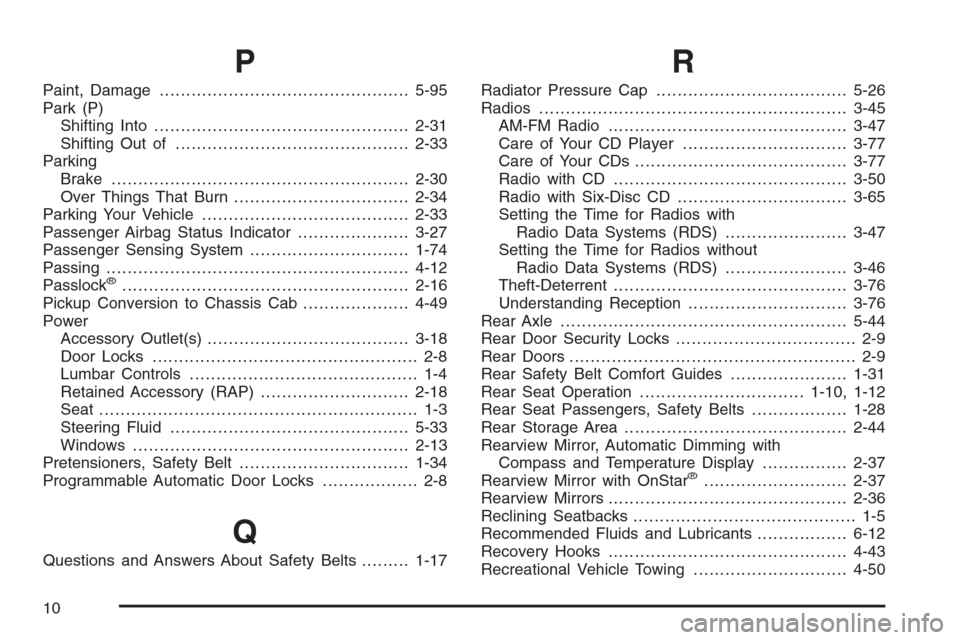
P
Paint, Damage...............................................5-95
Park (P)
Shifting Into................................................2-31
Shifting Out of............................................2-33
Parking
Brake........................................................2-30
Over Things That Burn.................................2-34
Parking Your Vehicle.......................................2-33
Passenger Airbag Status Indicator.....................3-27
Passenger Sensing System..............................1-74
Passing.........................................................4-12
Passlock
®......................................................2-16
Pickup Conversion to Chassis Cab....................4-49
Power
Accessory Outlet(s)......................................3-18
Door Locks.................................................. 2-8
Lumbar Controls........................................... 1-4
Retained Accessory (RAP)............................2-18
Seat ............................................................ 1-3
Steering Fluid.............................................5-33
Windows....................................................2-13
Pretensioners, Safety Belt................................1-34
Programmable Automatic Door Locks.................. 2-8
Q
Questions and Answers About Safety Belts.........1-17
R
Radiator Pressure Cap....................................5-26
Radios..........................................................3-45
AM-FM Radio.............................................3-47
Care of Your CD Player...............................3-77
Care of Your CDs ........................................3-77
Radio with CD............................................3-50
Radio with Six-Disc CD................................3-65
Setting the Time for Radios with
Radio Data Systems (RDS).......................3-47
Setting the Time for Radios without
Radio Data Systems (RDS).......................3-46
Theft-Deterrent............................................3-76
Understanding Reception..............................3-76
Rear Axle......................................................5-44
Rear Door Security Locks.................................. 2-9
Rear Doors...................................................... 2-9
Rear Safety Belt Comfort Guides......................1-31
Rear Seat Operation...............................1-10, 1-12
Rear Seat Passengers, Safety Belts..................1-28
Rear Storage Area..........................................2-44
Rearview Mirror, Automatic Dimming with
Compass and Temperature Display................2-37
Rearview Mirror with OnStar
®...........................2-37
Rearview Mirrors.............................................2-36
Reclining Seatbacks.......................................... 1-5
Recommended Fluids and Lubricants.................6-12
Recovery Hooks.............................................4-43
Recreational Vehicle Towing.............................4-50
10